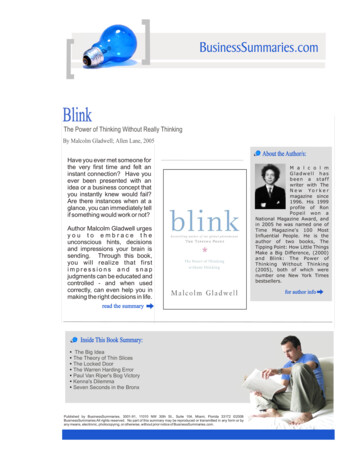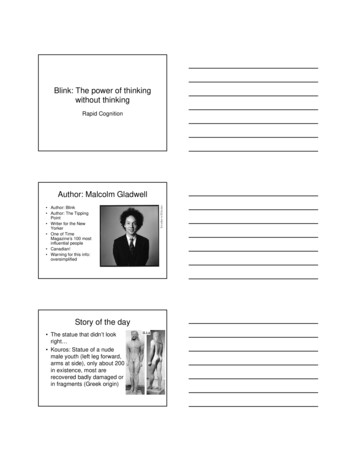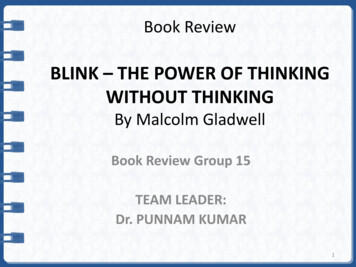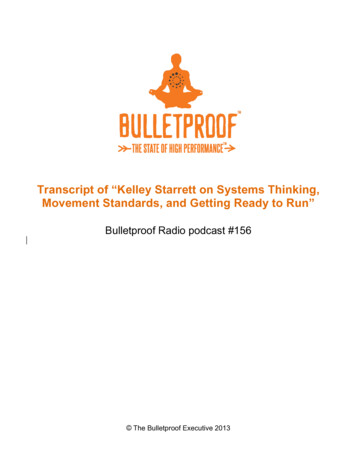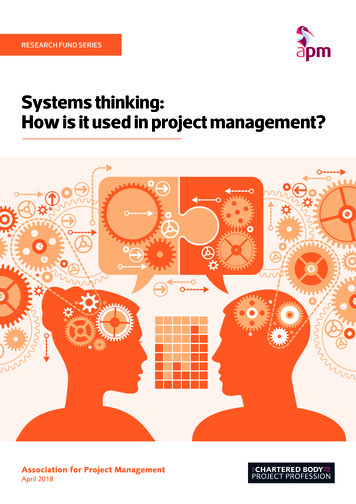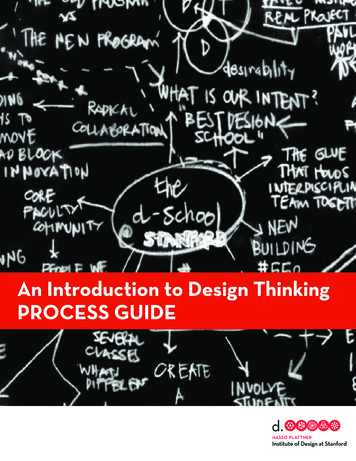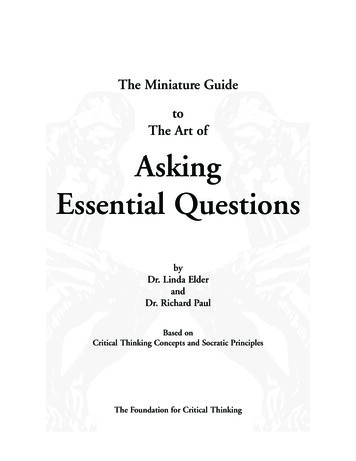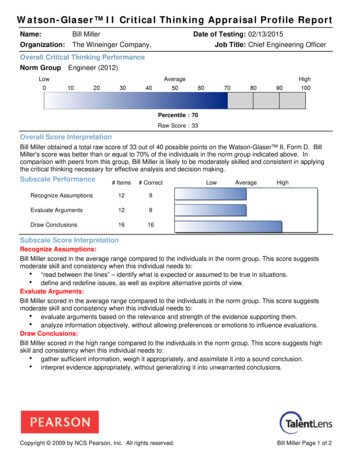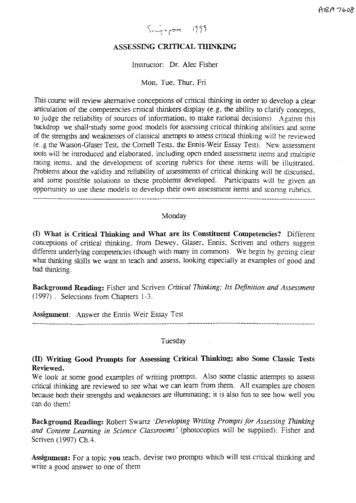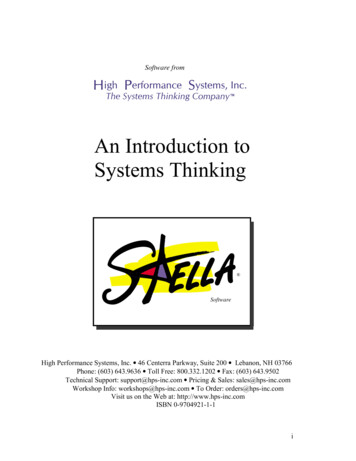
Transcription
Software fromAn Introduction toSystems Thinking SoftwareHigh Performance Systems, Inc. 46 Centerra Parkway, Suite 200 Lebanon, NH 03766Phone: (603) 643.9636 Toll Free: 800.332.1202 Fax: (603) 643.9502Technical Support: support@hps-inc.com Pricing & Sales: sales@hps-inc.comWorkshop Info: workshops@hps-inc.com To Order: orders@hps-inc.comVisit us on the Web at: http://www.hps-inc.comISBN 0-9704921-1-1i
STELLA and STELLA Research software Copyright 1985, 1987, 1988, 19901997, 2000, 2001 High Performance Systems, Inc. STELLA software Copyright 2003. All rights reserved.Introduction to Systems Thinking, STELLA 1992-1997, 2000, 2001 HighPerformance Systems, Inc. All rights reserved.It is against the law to copy the STELLA software for distribution without the priorwritten consent of High Performance Systems, Inc. Under the law, copying includestranslation of the software into another language or format. Licensee agrees to affixto, and present with, all permitted copies, the same proprietary and copyright noticesas were affixed to the original, in the same manner as the original.No part of this publication may be reproduced, stored in a retrieval system, ortransmitted, in any form or by any means, electronic, mechanical, photocopying,recording, or otherwise, without prior written permission from High PerformanceSystems, Inc.STELLA is a registered trademark of High Performance Systems, Inc. Macintosh is atrademark of Apple Computer, Inc. Windows is a trademark of MicrosoftCorporation. Other brand names and product names are trademarks or registeredtrademarks of their respective companies.High Performance Systems, Inc.’s Licensor makes no warranties, express orimplied, including without limitation the implied warranties of merchantabilityand fitness for a particular purpose, regarding the software. High PerformanceSystems, Inc.’s Licensor does not warrant, guaranty, or make anyrepresentations regarding the use or the results of the use of the software interms of its correctness, accuracy, reliability, currentness, or otherwise. Theentire risk as to the results and performance of the software is assumed by you.The exclusion of the implied warranties is not permitted by some states. Theabove exclusion may not apply to you.In no event will High Performance Systems, Inc.’s Licensor, and their directors,officers, employees, or agents (collectively High Performance Systems, Inc.’sLicensor) be liable to you for any consequential, incidental, or indirect damages(including damages for loss of business profits, business interruption, loss ofbusiness information, and the like) arising out of the use of, or inability to use,the software even if High Performance Systems, Inc.’s Licensor has been advisedof the possibility of such damages. Because some states do not allow theexclusion or limitation of liability for consequential or incidental damages, theabove limitations may not apply to you.ii
DedicationBarry M. Richmond1946-2002We at HPS will always remember Barry for his intensity, passion,creativity, and commitment to excellence in all aspects of hisprofessional and personal life. Over the years, HPS has been shapedby these attributes, and our products and services all show Barry'sinfluence.We are dedicated to continuing along the path that Barry has definedfor us. In the coming years, we will continue to develop and deliverproducts and services that will improve the world by helping peopleto think, learn, communicate, and act more systemically.Your Family and Friends at HPS
iv
AcknowledgementsThis Guide was written by Barry Richmond.support of various kinds from various people.He received greatNancy Maville, and Steve Peterson read and provided feedback on theChapters. Steve also did a superb job of readying all of the modelsassociated with the Guide, as well as creating the Index. DebraGonzales formatted the text and Index, and also helped with renderingmany of the Figures.We hope you enjoy the fruits of our labor.May, 2001v
vi
ContentsPart 1.Chapter 1.The Language of Systems Thinking:1Operational, Closed-loop & Non-linear ThinkingSystems Thinking and the STELLA Software:3Thinking, Communicating, Learning and Acting MoreEffectively in the New MillenniumChapter 2.Nouns & VerbsOperational Thinking35Chapter 3.Writing SentencesOperational Thinking45Chapter 4.Linking SentencesOperational Thinking51Chapter 5.Constructing Simple ParagraphsClosed-loop Thinking61Appendix: Generic Flow Templates73Constructing “More Interesting” ParagraphsClosed-loop & Non-linear Thinking79Appendix: Formulating Graphical Functions90Chapter 7.Short Story ThemesGeneric Infrastructures95Part 2.The “Writing” Process10,000 Meter, System as Cause, Dynamic,Scientific and Empathic Thinking107Chapter 8.An Overview of the “Writing” Process109Chapter 9.Illustrating the “Writing” Process121Chapter 6.
Chapter 10.Guidelines for the “Writing” Process141Appendix: Initializing Models in Steady-state 154List of Figures157Index161viii
Part 1The Language of Systems Thinking:Operational, Closed-loop & Non-linear ThinkingWe believe that constructing a good model using the STELLA softwareis very much analogous to writing a good composition, such as a shortstory, screenplay, or novel.And, because people have morefamiliarity with writing than they do with modeling, we’ve decided torely pretty extensively on the analogy in hopes of accelerating youruptake of the modeling language, concepts, and process. Each of theremaining chapters in this Guide will draw upon the writing analogy.As the title to this Part suggests, there is a parallel progression in thechapters that comprise it. One track is language. You’ll begin, inChapter 2, by learning the basic parts of speech in the stock/flowlanguage. Chapter 3 will present the rules of grammar for constructinggood sentences. In Chapter 4, you’ll learn how to link sentencestogether. Chapters 5 and 6 will discuss how to compose first simple,then complex, paragraphs. Finally, Chapter 7 will illustrate howparagraphs can be put together to create a short story.Paralleling the language track is the development of Systems Thinkingskills. The chapters in this Part will focus on developing three keySystems Thinking skills: Operational, Closed-loop, and Non-linearThinking.The language and the thinking skills really are intertwined. Youcannot write a good short story, or even compose a good sentence,unless you have a solid grasp of both the language and the associatedthinking skills that enable you to apply it effectively.1
2
Chapter 1Systems Thinking and the STELLA Software:Thinking, Communicating, Learning and Acting MoreEffectively in the New MillenniumI have been writing and re-writing this Guide for fifteen years. Ialways begin Chapter 1 by reeling off a litany of serious challengesfacing humanity. And, you know what? The list has remained prettymuch the same! There’s homelessness and hunger, drug addiction andincome distribution inequities, environmental threats and the scourgeof AIDS. We’ve made precious little progress in addressing any ofthese issues over the last couple of decades! Indeed, you could make astrong case that, if anything, most (if not all) have gotten worse! And,some new challenges have arisen. Perhaps most disturbing amongthese is what appears to be (so far) largely an American phenomenon:kids killing kids (and teachers), at school.So what’s the problem? Why do we continue to make so littleprogress in addressing our many, very pressing social concerns?My answer is that the way we think, communicate, and learn isoutdated. As a result, the way we act creates problems. And then,we’re ill-equipped to address them because of the way we’ve beentaught to think, communicate and learn. This is a pretty sweepingindictment of some very fundamental human skills, all of which ourschool systems are charged with developing! However, it is thepremise of this Chapter (and Systems Thinking) that it is possible toevolve our thinking, communicating and learning capacities. As wedo, we will be able to make progress in addressing the compellingslate of issues that challenge our viability. But in order to achieve thisevolution, we must overcome some formidable obstacles. Primaryamong these are the entrenched paradigms governing what and howstudents are taught. We do have the power to evolve these paradigms.It is now time to exercise this power!I will begin by offering operational definitions of thinking,communicating and learning. Having them will enable me to shinelight on precisely what skills must be evolved, how current paradigmsare thwarting this evolution, and what Systems Thinking and theSTELLA software can do to help. Finally, I’ll overview what’s to comein the remainder of the Guide. In the course of this Chapter, I willidentify eight Systems Thinking skills. They are: 10,000 Meter,3
System as Cause, Dynamic, Operational, Closed-loop, Non-linear,Scientific, and Empathic Thinking. Each will reappear, somereceiving more attention than others, throughout the Guide. It ismastery of these skills that will enable you to make effective use of theSTELLA software.ProvidingOperationalDefinitionsThe processes of thinking, communicating, and learning constitute aninterdependent system, or at least have the potential for operating assuch. They do not operate with much synergy within the currentsystem of formal education. The first step toward realizing thepotential synergies is to clearly visualize how each process works inrelation to the other. I’ll use the STELLA software to help with thevisualization ThinkingThinking we all do it. But what is it? The dictionary says it’s “ tohave a thought; to reason, reflect on, or ponder.” Does that clear it upfor you? It didn’t for me.I will define thinking as consisting of two activities: constructingmental models, and then simulating them in order to draw conclusionsand make decisions. We’ll get to constructing and simulating in amoment. But first, what the heck is a mental model?It’s a “selective abstraction” of reality that you create and then carryaround in your head. As big as some of our heads get, we still can’t fitreality in there. Instead, we have models of various aspects of reality.We simulate these models in order to “make meaning” out of whatwe’re experiencing, and also to help us arrive at decisions that informour actions.For example, you have to deal with your kid, or a sibling, or yourparent. None of them are physically present inside your head. Instead,when dealing with them in a particular context, you select certainaspects of each that are germane to the context. In your mind’s eye,you relate those aspects to each other using some form of cause-andeffect logic. Then, you simulate the interplay of these relationshipsunder various “what if” scenarios to draw conclusions about a bestcourse of action, or to understand something about what has occurred.If you were seeking to understand why your daughter isn’t doing wellin arithmetic, you could probably safely ignore the color of her eyeswhen selecting aspects of reality to include in the mental model youare constructing. This aspect of reality is unlikely to help you indeveloping an understanding of the causes of her difficulties, or indrawing conclusions about what to do. But, in selecting a blouse forher birthday? Eye color probably ought to be in that mental model.As the preceding example nicely illustrates, all models (mental andotherwise) are simplifications. They necessarily omit many aspects of4
the realities they represent. This leads to a very important statementthat will be repeated several times throughout this Guide. Thestatement is a paraphrase of something W. Edwards Deming (thefather of the “Quality movement”) once uttered: “All models arewrong, some models are useful.” It’s important to dredge thishallowed truth back up into consciousness from time to time to preventyourself from becoming “too attached” to one of your mental models.Nevertheless, despite the fact that all models are wrong, you have nochoice but to use them—no choice that is, if you are going to think. Ifyou wish to employ non-rational means (like gut feel and intuition) inorder to arrive at a conclusion or a decision, no mental model isneeded. But, if you want to think you can’t do so without a mentalmodel!Figure 1-1 presents a STELLA map of the activities that comprise“thinking:” constructing (a mental model), and simulating in order todraw conclusions. As the Figure indicates, constructing is divided intotwo sub-activities: selecting and representing. The first sub-activityanswers the question: What should I include in my mental model? Thesecond sub-activity answers the question: How should I represent whatI include? These are the two fundamental questions that must beanswered in constructing any mental model. It is my conviction thatthe paradigms currently governing teaching in our schools restrictdevelopment of the whole set of skills needed to become effective inexecuting both the constructing and simulating activities. That is, ourschools are thwarting development of thinking capacity—somethingno school board would approve, and we can ill afford!ConstructingAll PossibleElementsselectingElements Included in theMental ModelRepresented Elementsin the Mental atingConclusions& DecisionsFigure 1-1.A STELLA Picture of “Thinking.”drawing\making5
The “wire” that runs from Represented Elements in the Mental Modelto simulating is intended to suggest that simulating cannot proceeduntil a mental model is available—which is to say, the selecting andrepresenting activities have been executed.Simulating yieldsconclusions that, among other things, help us to make decisions. But,as Figure 1-1 indicates, simulation outcomes play another importantrole in the thinking process. They provide feedback to the selectingand representing activities (note the “wires” running from S
i Software from An Introduction to Systems Thinking High Performance Systems, Inc. 46 Centerra Parkway, Suite 200 Lebanon, NH 03766 Phone: (603) 643.9636 Toll Free: 800.332.1202
